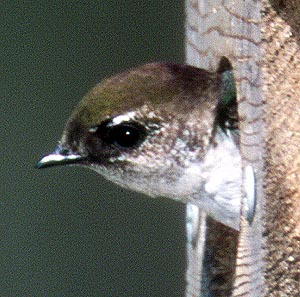
Photos © Peter LaTourrette
All rights reserved.

 Photos © Peter LaTourrette All rights reserved. |
 |
Several people were misled, thinking the gull was photographed in California. I agree that if I saw this bird in California I would try mightily to turn it into a worn Glaucous-winged Gull. However, I think the bill shape is wrong for Glaucous-winged which usually has a heavier bill. I am afraid that the eye color may be misleading. It shows as light in other photos of this bird. Glaucous-winged Gulls normally show wingtips which are about the same color as the mantle or slightly darker, even in summer and even in subadult plumages. I think a Glaucous-winged Gull like this, with pure white wingtips and gray mantle, would be rather unusual. I'd like to apologize to all those who were misled. It was completely unintentional.
When I selected the gull, I intended it to be a warning about claiming Iceland Gulls out of range, particularly on the West Coast. Most Glaucous Gulls seen on the West Coast are of the small race L. h. barrovianus which are slightly darker on the mantle, and have a noticeably smaller and thinner bill than other Glaucous Gull subspecies. An abstract of Richard Bank's paper on Glaucous Gull variation has been posted here.
Such small Glaucous Gulls may be confused with Iceland Gulls. One feature often used is the ratio of the bill length to wing-tip projection beyond the tail. On Iceland Gull the bill is short and the wings are long, so the bill appears shorter than the length of wing projecting beyond the tail. On Glaucous Gull, this ratio is reversed. In the quiz photo, the wingtips seem to be longer than the bill, suggesting Iceland. The bill may be foreshortened by the angle of the head; but I have seen photos by Larry Spear of very small looking presumed Glaucous Gulls in the Bearing Sea which seem to defy the expected bill/wingtip proportions.
Another feature is the size of the eye. Iceland Gulls have a relatively larger eye with respect to their small bill. Many years ago, the late Peter Grant tried to show me how to quantify that by measuring the area of the eye and projecting it against the area of the bill in profile. It was an interesting idea that I don't believe has ever been published. In any event, it would be difficult to use in the field.
For pictures of what a real Iceland Gull might look like, you can view one of the first accepted California records at the CBRC photo gallery. I think a comparison of photos of the Bodega Bay bird (which was originally suspected of being a small Glaucous Gull) and the Nome bird above is quite interesting. Note that some Iceland Gulls of the race L. g. kulieni (the subspecies of Iceland occurring in most of North America) may have white wingtips. Thus the race of the Bodega Bay bird cannot be determined.
The swallow did not cause as many problems, although there was confusion about the age of the bird. On my monitor,
the back looks dark forest green, contrasting strongly with a brownish nape. This is quite typical for adult female
Violet-green Swallows and I believe that's what this bird is. However, female Violet-green Swallows may be difficult
to age. Characters proposed by Pyle Identification Guide to North American Birds include contrast between
the back and the wing-coverts. That character cannot be assessed here, but juvenile birds should normally be all
brown on the back. Some observers are not aware of how dark the face of adult female Violet-green Swallows can
get. My intent was to focus on that. The short white supercilium is an excellent character however, and should
separate any female Violet-green from Tree Swallow.